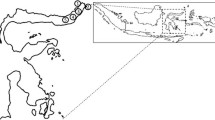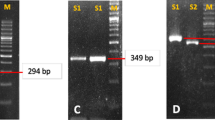Abstract
Helicobacter pylori (H. pylori) is a gramnegative bacillus thought to be involved in such diseases of the upper gastrointestinal tract as gastritis, peptic ulcers, and gastric cancer. Urease is regarded as the factor responsible for the pathogenic nature of this bacterium. Therefore, in our examination of the genetic polymorphism ofH. pylori, by means of Southern blotting, we used the urease gene as a probe. The Southern blot patterns ofH. pylori isolated from different patients differed greatly, the inter-individual variation being so marked that it allowed approximate distinction between individual patients. The Southern blot patterns of individual strains ofH. pylori did not change, even when they were stored and passed from generation to generation in our laboratory. These results suggest that DNA fingerprints with a urease gene probe will be useful in epidemiologically tracingH. pylori infection. Almost all strains ofH. pylori isolated from different sites in the stomach of a patient on different occasions showed the same pattern, allowing us to confirm that only one strain ofH. pylori was responsible forH. pylori infection in individual patients.
Similar content being viewed by others
References
Warren J, Marshall B. Unidentified curved bacilli on gastric epithelium in active chronic gastritis. Lancet 1983;1:1273–1275.
Rauws EAJ, Langenberg W, Houthoff HJ, et al.Campylobacter pyloridis-associated chronic antral gastritis. Gastroenterology 1988;94:33–40.
Graham DY.Helicobacter pylori. Its epidemiology and its role in duodenal ulcer disease. J Gastroenterol Hepatol 1991; 6:97–105.
Dixon MF.Helicobacter pylori and peptic ulceration. J Gastroenterol Hepatol 1991:125–130.
Parsonnet J, Friedman GD, Vandersteen DP, et al.Helicobacter pylori infection and the risk of gastric carcinoma. N Engl J Med 1991;325:1127–1131.
Fukuda Y, Yamamoto I, Tonokatsu Y, et al. Inoculation of animals with humanHelicobacter pylori and long-term investigation ofHelicobacter pylori-associated gastritis. Eur J Gastroenterol Hepatol 1992;4[Suppl]:39–44.
Inoue H, Yamamoto I, Tanida N, et al.Campylobacter pylori in Japan: Bacteriological features and prevalence in healthy subjects and patients with gastroduodenal disorders. Gastroenterol Jpn 1989;24:494–504.
Kawaura A, Yamamoto I, Tanida N, et al.Helicobacter pylori is not a co-carcinogen in N-methyl-N′-nitrosoguanidine-induced rat gastric carcinogenesis. Tokushima J Exp Med 1991;38:71–75.
Inoue H, Ishii E, Tsuyuguchi T, et al. Isolation ofCampylobacter pyloridis in the biopsy specimens of human stomach mucosa, searching forCampylobacter-like organisms (CLO) (in Japanese). J J A Inf D 1985;59[Suppl]:163.
Langenberg W, Rauws EAJ, Widjojokusumo A, et al. Identification ofCampylobacter pyloridis isolates by restriction endonuclease DNA analysis. J Clin Microbiol 1986;24:414–417.
Majewski SI, Goodwin CS. Restriction endonuclease analysis of the genome ofCampylobacter pylori with a rapid extraction method: Evidence for considerable genomic variation. J Infect Dis 1988;157:465–471.
Morgan DD, Owen RJ. Use of DNA restriction endonuclease digest and ribosomal RNA gene probe patterns to fingerprintHelicobacter pylori andHelicobacter mustelae from human and animal hosts. Molec cell prob 1990;4:321–334.
Tee W, Lambert J, Smallwood R, et al. Ribotyping ofHelicobacter pylori from clinical specimens. J Clin Microbiol 1992; 30:1562–1567.
Goodwin CS, Armstrong JA, Peter M. Microbiology ofC. pylori. In: Blaser MJ (ed)Campylobacter pylori in gastritis and peptic ulcer disease. New York: Igaku-Shoin, 1989:25–49.
Wilson K. Preparation of genomic DNA From bacteria. In: Current Protocols in Molecular Biology. Vol. 1. Ausubel FM, Brent R, Kingston RE, Moore DD, Seidman JG, Smith JA, Struhl K. New York: John Wiley & Sons. 1989;2,4:1–2
Tonokatsu Y, Hayashi T, Mizuta T, et al. Restriction fragment length polymorphism ofHelicobacter pylori using the urease gene probe. Gastroenterol Jpn 1991;26:788.
Clayton CL, Pallen MJ, Kleanthous H, et al. Nucleotide sequence of two genes fromHelicobacter pylori encoding for urease subunit. Nucleic Acids Res 1990;18:362.
Altwegg M, Hickman-Brenner FW, Farmer JJ III. Ribosomal RNA gene restriction patterns provide increased sensitivity for typingSalmonella typhi strains. J Infect Dis 1989;160:145–149.
Esteban E, Snipes K, Hird D, et al. Use of ribotyping for characterization ofSalmonella serotypes. J Clin Microbiol 1993;31:233–237.
Author information
Authors and Affiliations
Rights and permissions
About this article
Cite this article
Tonokatsu, Y., Hayashi, T., Fukuda, Y. et al. A clinico-epidemiological analysis ofHelicobacter pylori (H. pylori) by Southern blotting with A urease gene probe. J Gastroenterol 29, 120–124 (1994). https://doi.org/10.1007/BF02358671
Received:
Accepted:
Issue Date:
DOI: https://doi.org/10.1007/BF02358671




